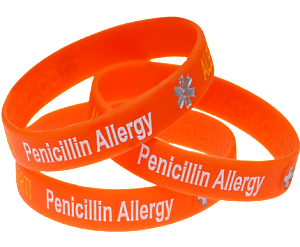Allergy
-
Meet Happy Tummies! The Food Allergies Store!
Happy Tummies is an online shop for families affected by food allergies and food intolerances. Lisa Munro and her husband Chris decided to start Happy Tummies for this suffering from allergies about three and half years ago. The inspiration came from Alex, their son who has multiple food allergies and eosinophilic oesophagitis. They were tired of wasting their weekends driving from... -
Allergy Wristbands Should Be Part of Your Anti-Allergy Kit
If you are one of the millions of Australians who suffer from an allergy, you will understand how miserable and unpleasant an allergic reaction can be. It is estimated that around 4.1 million Australians have an allergy of some sort, a figure which represents almost a fifth of our population. Of these 4.1 million individuals, each has an average of 1.74 allergies, which means there are around 7.2 million cases of allergic diseases shared among the population. These figures illustrate just how serious Australia’s allergy problem really is; in fact, the ASCIA-Access Economics Report estimates that Australia and New Zealand have the highest prevalence of allergies in the developed world. Continue reading →
Of these 4.1 million individuals, each has an average of 1.74 allergies, which means there are around 7.2 million cases of allergic diseases shared among the population. These figures illustrate just how serious Australia’s allergy problem really is; in fact, the ASCIA-Access Economics Report estimates that Australia and New Zealand have the highest prevalence of allergies in the developed world. Continue reading → -
Medical ID Bracelet - The Foolproof Way To Ensuring Your Child's Safety
 Children with illnesses such as diabetes, asthma or epilepsy, among other life-threatening diseases, should carry easily visible information to ensure passers-by can quickly understand that they need help in the event of an emergency when you’re not around.
While you could have them carry a slip in their pocket or wallet detailing their condition, paper can get damaged or lost. A medical ID bracelet is worn on the wrist and is indestructible. A allergy or medical ID bracelet also provides immediate visibility to passers-by and first responders, giving parents invaluable peace of mind when separated from their children.
Not the average medical ID bracelet
Little ones can be very obstinate and may not want to show the world – or their peers – that they have a medical condition. That’s where Medibands come in. Unlike other medical ID bracelets, Medibands for kids aren’t the stereotypical, unattractive bands your child may have seen on an older person – and associated with being uncool. They're slimline and colourful as opposed to being chunky and dull to look at, and come in an array of alternative colours and styles.
Get your child to pick out their own Mediband to make sure they feel like it's their choice to wear it and that it represents their own tastes and interests. Kids that have chosen their personal colours and styles for their Mediband are more likely to keep it at all times. Continue reading →
Children with illnesses such as diabetes, asthma or epilepsy, among other life-threatening diseases, should carry easily visible information to ensure passers-by can quickly understand that they need help in the event of an emergency when you’re not around.
While you could have them carry a slip in their pocket or wallet detailing their condition, paper can get damaged or lost. A medical ID bracelet is worn on the wrist and is indestructible. A allergy or medical ID bracelet also provides immediate visibility to passers-by and first responders, giving parents invaluable peace of mind when separated from their children.
Not the average medical ID bracelet
Little ones can be very obstinate and may not want to show the world – or their peers – that they have a medical condition. That’s where Medibands come in. Unlike other medical ID bracelets, Medibands for kids aren’t the stereotypical, unattractive bands your child may have seen on an older person – and associated with being uncool. They're slimline and colourful as opposed to being chunky and dull to look at, and come in an array of alternative colours and styles.
Get your child to pick out their own Mediband to make sure they feel like it's their choice to wear it and that it represents their own tastes and interests. Kids that have chosen their personal colours and styles for their Mediband are more likely to keep it at all times. Continue reading → -
Medical Alert Bracelets: Helping to Keep You and Your Loved Ones Safe
 Whether you’re an elderly person's family member, friend, or caregiver, you know how difficult it can be to keep them safe at all times. It’s important to do whatever we can to enhance their quality of life, including taking precautions should something go wrong.
Wearing Mediband medical alert bracelets is one way to do this. Medibands are made of durable silicone and are custom made to show the exact ailments suffered by your loved one. Your bracelet provides crucial information to passers-by and first responders when your loved one is unable to talk for themselves. Continue reading →
Whether you’re an elderly person's family member, friend, or caregiver, you know how difficult it can be to keep them safe at all times. It’s important to do whatever we can to enhance their quality of life, including taking precautions should something go wrong.
Wearing Mediband medical alert bracelets is one way to do this. Medibands are made of durable silicone and are custom made to show the exact ailments suffered by your loved one. Your bracelet provides crucial information to passers-by and first responders when your loved one is unable to talk for themselves. Continue reading → -
Allergy Bracelets
 One of the most common medical allergies is to penicillin – possibly because it is one of the most common antibiotics of all time. Having an allergy bracelet that tells treating professionals you are allergic to penicillin is one of the surest ways to prevent disastrous anaphylactic shock. Anaphylactic shock is an extreme – and rare – event. Most people simply come out in symptoms like rashes, hives, itchy eyes and swollen lips, tongue, or face. The symptoms of an anaphylactic reaction, which can be deadly, usually happen within an hour of taking penicillin. Symptoms include difficulty breathing, hives, wheezing, dizziness, loss of consciousness, rapid or weak pulse, skin turning blue, diarrhoea, nausea, and vomiting. Continue reading →
One of the most common medical allergies is to penicillin – possibly because it is one of the most common antibiotics of all time. Having an allergy bracelet that tells treating professionals you are allergic to penicillin is one of the surest ways to prevent disastrous anaphylactic shock. Anaphylactic shock is an extreme – and rare – event. Most people simply come out in symptoms like rashes, hives, itchy eyes and swollen lips, tongue, or face. The symptoms of an anaphylactic reaction, which can be deadly, usually happen within an hour of taking penicillin. Symptoms include difficulty breathing, hives, wheezing, dizziness, loss of consciousness, rapid or weak pulse, skin turning blue, diarrhoea, nausea, and vomiting. Continue reading →




